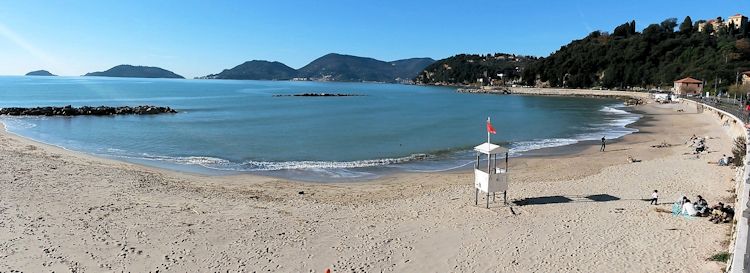Lerici and San Terenzo
Lerici is sea.

Gets for years prestigious awards such as the Blue Flag and the Four Sails by Legambiente.
Lerici is also nature: its territory is included in the Monte Marcello Magra Natural Park, large protected area dominated by Mediterranean fauna.
Lerici is the ideal destination for all those who expect from an holiday peace, relax, contact with the sea and nature.
For lovers of trekking and hiking, there are many scenic trails developing through the town to reach: Leric's pittoresques hilly villages, dramatic cliffs, hidden coves and the secluded villages of Fiascherino and Tellaro.
The territory, destination at any time of poets and artists of great renown, was denomimated "The Gulf of Poets". All over the world Lerici is known with this name.
San Terenzo and beaches.
With its convenient location, San Terenzo has maintained intact its appearance of a typical Ligurian village where the sea and the beach are one with the houses.
At the eastern end there is the castle: a quadrangular fortress built in the late Middle Ages on top of a hill that juts out on the wide, sandy beaches and clear blue waters. San Terenzo has a wide beach which stretches in front of the multi-colored houses, a walk to the west beneath the rocky cliffs, the castle tower and the walk "from castle to castle" between the two villages of Lerici and San Terenzo.
Lerici and history
The town of Lerici is situated in the Riviera di Levante, on the eastern shore of the Gulf of La Spezia. Stands at the center of a small natural bay, called Seno of Lerici and dominated by a headland on which stands the imposing castle, now a museum. Almost opposite the village, over the location known as "Venere Azzurra", lies the village of San Terenzo.
Geopaleontology Museum in the castle of Lerici. The museum has its origin on the discovery of footprints of dinosaurs and other reptiles, dating back over 220 million years ago, by Ilario Sirigu, passionate amateur scholar who died prematurely: in the wake of this discovery, the museum re-starts in Lerici a tradition of learning geopaleontology began in the nineteenth century, when Giovanni Cappellini, one of the founders of modern geology in Italy, in the promontories of the Gulf started the first searches.
San Terenzo and history
San Terenzo existed as an independent village in the Middle Ages: a village of fishermen and sailors, also dedicated to the traffic of wine and oil and in which settled, among other things, a hospital, which name was Portiolo (probably meant "port of oil' or small port; according to legend, he landed the friar Terenzio who intended to go to Rome on pilgrimage. Not far from the village, the friar was murdered by brigands and local villages competed for the right to withhold the corpse. To settle the matter was decided to put the body on a cart pulled by oxen, and where the oxens would stop exhausted, there would have been buried Terence: this was where the present village of San Terenzo is. A painting of Fiasella in the church immortalizes the landing of the friar. Several place names in the area remember the times of the Crusades in particular the grave of the Crusader and the Rock of Orlando (which, according to legend, was broken in two by the fury of the rider).

 Syntropy
Syntropy